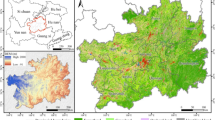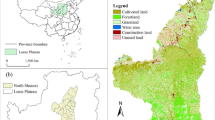Abstract
Studying an ecological restoration zoning process under the background of ecological security patterns is of great significance to the rapid adjustment and optimization of a landscape pattern. In this study, a remote sensing ecological index and a morphological spatial pattern analysis method were used to assess the quality of habitats and identify ecological sources in the city of Ningbo; ecological corridors, ecological pinch points, and ecological barrier points were extracted by using a circuit theory to construct ecological security patterns and ecological restoration zones. The results indicate: (1) There were 47 ecological sources, and 83 key ecological corridors in Ningbo, and the ecological land area was about 1898.39 km2, accounting for 19.89% of the total study area. (2) The ecological source areas were distributed in “one patch and three belts”, and the low-resistance ecological corridors were concentrated in southern Yuyao city, western Haishu district, and central and western Fenghua district; the ecological network in the western and southern regions was dense. (3) There were four types of ecological restoration zones that need to be established, which were prioritized restoration zones, prioritized protection zones, key conservation zones, and general conservation zones distributed hierarchically from inner part towards outside. (4) Ninghai county, Yuyao city, and Fenghua district had large ecological land areas, however, prioritized restoration and protection zones in Ninghai and Fenghua were also large. The analysis results are expected to provide a reference for optimizing a territorial ecological space in a city.
Similar content being viewed by others
References
An Y, Liu S, Sun Y et al., 2021. Construction and optimization of an ecological network based on morphological spatial pattern analysis and circuit theory. Landscape Ecology, 36(7): 2059–2076.
Carpenter S R, Mooney H A, Agard J et al., 2009. Science for managing ecosystem services: Beyond the Millennium Ecosystem Assessment. Proceedings of the National Academy of Sciences, 106(5): 1305–1312.
Carroll C, McRAE B H, Brookes A, 2012. Use of linkage mapping and centrality analysis across habitat gradients to conserve connectivity of gray wolf populations in western North America. Conservation Biology, 26(1): 78–87.
Chen X, Zhou C H, 2005. Review of the studies on ecological security. Progress in Geography, 24(6): 8–20. (in Chinese)
Dai L, Liu Y, Luo X, 2021. Integrating the MCR and DOI models to construct an ecological security network for the urban agglomeration around Poyang Lake, China. Science of The Total Environment, 754: 141868.
Dong J Q, Peng J, Xu Z H et al., 2021. Integrating regional and interregional approaches to identify ecological security patterns. Landscape Ecology: 1–14.
Fang Y, Wang J, Huang L Y et al., 2020. Determining and identifying key areas of ecosystem preservation and restoration for territorial spatial planning based on ecological security patterns: A case study of Yantai city. Journal of Natural Resources, 35(1): 190–203. (in Chinese)
Fu Y J, Shi X Y, He J et al., 2020. Identification and optimization strategy of county ecological security pattern: A case study in the Loess Plateau, China. Ecological Indicators, 112: 106030.
Huang M Y, Yue W Z, Feng S R et al., 2019. Analysis of spatial heterogeneity of ecological security based on MCR model and ecological pattern optimization in the Yuexi county of the Dabie Mountain Area. Journal of Natural Resources, 34(4): 771–784. (in Chinese)
Jiang H, Peng J, Dong J Q et al., 2021. Linking ecological background and demand to identify ecological security patterns across the Guangdong-Hong Kong-Macao Greater Bay Area in China. Landscape Ecology, 1–16.
Kavanagh P, Newlands N, Christensen V et al., 2004. Automated parameter optimization for Ecopath ecosystem models. Ecological Modelling, 172(2–4): 141–149.
Li G M, He B B, Li L et al., 2021. Ecological functions and human activity interference evaluation in ecological protection redline for urban environment. Photogrammetric Engineering & Remote Sensing, 87(6): 413–420.
Li S C, Xiao W, Zhao Y L et al., 2020a. Incorporating ecological risk index in the multi-process MCRE model to optimize the ecological security pattern in a semi-arid area with intensive coal mining: A case study in northern China. Journal of Cleaner Production, 247: 119143.
Li Z T, Li M, Xia B C, 2020b. Spatio-temporal dynamics of ecological security pattern of the Pearl River Delta urban agglomeration based on LUCC simulation. Ecological Indicators, 114: 106319.
Liao W H, Jiang W G, 2020. Evaluation of the spatiotemporal variations in the eco-environmental quality in China based on the remote sensing ecological index. Remote Sensing, 12(15): 2462.
Liu D, Chang Q, 2015. Ecological security research progress in China. Acta Ecologica Sinica, 35(5): 111–121.
Liu D, Lin N F, Zou C X et al., 2015. Development of foreign ecological protected areas and linkages to ecological protection redline delineation and management in China. Biodiversity Science, 23(6): 708.
Liu J, Yin H W, Kong F H et al., 2018. Structure optimization of circuit theory-based green infrastructure in Nanjing, China. Acta Ecologica Sinica, 38(12): 4363–4372. (in Chinese)
Liu Z F, He C Y, Wu J G, 2016. The relationship between habitat loss and fragmentation during urbanization: An empirical evaluation from 16 world cities. PLoS One, 11(4): e0154613.
Liu Z H, Huang Q D, Tang G P, 2021. Identification of urban flight corridors for migratory birds in the coastal regions of Shenzhen city based on three-dimensional landscapes. Landscape Ecology, 36(7): 2043–2057.
Ma K M, Fu B J, Li X Y et al., 2004. The regional pattern for ecological security (RPES): The concept and theoretical basis. Acta Ecologica Sinica, 24(4): 761–768. (in Chinese)
Ma L B, Bo J, Li X Y et al., 2019. Identifying key landscape pattern indices influencing the ecological security of inland river basin: The middle and lower reaches of Shule River Basin as an example. Science of the Total Environment, 674: 424–438.
McRae B H, Hall S A, Beier P et al., 2012. Where to restore ecological connectivity? Detecting barriers and quantifying restoration benefits. PloS One, 7(12): e52604.
McRae B H, Shah V B, 2009. Circuitscape User’s Guide. Santa Barbara: The University of California.
Pan J H, Liu X, 2015. Assessment of landscape ecological security and optimization of landscape pattern based on spatial principal component analysis and resistance model in arid inland area: A case study of Ganzhou District, Zhangye City, Northwest China. Chinese Journal of Applied Ecology, 26(10): 3126–3136. (in Chinese)
Peng J, Zhao S Q, Dong J Q et al., 2019. Applying ant colony algorithm to identify ecological security patterns in megacities. Environmental Modelling & Software, 117: 214–222.
Peng W F, Zhou J M, 2019. Development of land resources in transitional zones based on ecological security pattern: A case study in China. Natural Resources Research, 28(1): 43–60.
Song L L, Qin M Z, 2016. Identification of ecological corridors and its importance by integrating circuit theory. Chinese Journal of Applied Ecology, 27(10): 3344–3352. (in Chinese)
Tian P, Li J L, Cao L D et al., 2021. Assessing matching characteristics and spatial differences between supply and demand of ecosystem services: A case study in Hangzhou, China. Land, 10(6): 582.
Wang C X, Yu C Y, Chen T Q et al., 2020. Can the establishment of ecological security patterns improve ecological protection? An example of Nanchang, China. Science of The Total Environment, 740: 140051.
Xiong Y, Xu W H, Lu N et al., 2021. Assessment of spatial-temporal changes of ecological environment quality based on RSEI and GEE: A case study in Erhai Lake Basin, Yunnan province, China. Ecological Indicators, 125: 107518.
Xu H Q, 2013a. A remote sensing index for assessment of regional ecological changes. China Environmental Science, 33(5): 889–897. (in Chinese)
Xu H Q, 2013b. A remote sensing urban ecological index and its application. Acta Ecologica Sinica, 33(24): 7853–7862. (in Chinese)
Xu J Y, Fan F F, Liu Y X et al., 2019. Construction of ecological security patterns in nature reserves based on ecosystem services and circuit theory: A case study in Wenchuan, China. International Journal of Environmental Research and Public Health, 16(17): 3220.
Yang T R, Kuang W H, Liu W D et al., 2017. Optimizing the layout of eco-spatial structure in Guanzhong urban agglomeration based on the ecological security pattern. Geographical Research, 36(3): 441–452. (in Chinese)
Yin J B, Li H, Wang D Y et al., 2020. Optimization of rural settlement distributions based on the ecological security pattern: A case study of Da’an city in Jilin province of China. Chinese Geographical Science, 30(5): 824–838.
Yu F, Li X B, Wang H et al., 2006. Land use change and eco-security assessment of Huangfuchuan watershed. Acta Geographica Sinica, 61(6): 645–653. (in Chinese)
Yu K J, 1999. Landscape ecological security patterns in biological conservation. Acta Ecologica Sinica, 19(1): 8–15. (in Chinese)
Yu X L, Guo X L, Wu Z C, 2014. Land surface temperature retrieval from Landsat 8 TIRS: Comparison between radiative transfer equation-based method, split window algorithm and single channel method. Remote Sensing, 6(10): 9829–9852.
Zhang L Q, Peng J, Liu Y X et al., 2017. Coupling ecosystem services supply and human ecological demand to identify landscape ecological security pattern: A case study in Beijing-Tianjin-Hebei region, China. Urban Ecosystems, 20(3): 701–714.
Author information
Authors and Affiliations
Corresponding author
Additional information
Foundation: National Natural Science Foundation of China, No.41976209
Author: Zhang Haitao (1997–), Master Candidate, specialized in coastal ecological environment.
Rights and permissions
About this article
Cite this article
Zhang, H., Li, J., Tian, P. et al. Construction of ecological security patterns and ecological restoration zones in the city of Ningbo, China. J. Geogr. Sci. 32, 663–681 (2022). https://doi.org/10.1007/s11442-022-1966-9
Received:
Accepted:
Published:
Issue Date:
DOI: https://doi.org/10.1007/s11442-022-1966-9




